► 720S is new name for second-gen Super Series
► Internally codenamed P14, replaces 650S
► 710bhp 4.0-litre V8, 0-124mph in 7.8sec
McLaren Automotive’s torrent of new models continues unabated with the launch of its new 720S supercar, the Woking-based company’s first second-generation model.
One of the stars of the 2017 Geneva motor show, the 720S – internally designated P14 – replaces the current 650S when it goes on sale in May wearing a £208,600 price tag.
720S: the new McLaren Super Series
The Super Series lies at the heart of the McLaren line-up – the 650S that the 720S replaces started life as the MP4-12C in 2011, the company’s first mainstream modern road car. As the standard-bearer for McLaren’s performance prowess, the 720S, which is 90% new in terms of componentry, steps in to the supercar ring with some truly impressive credentials.
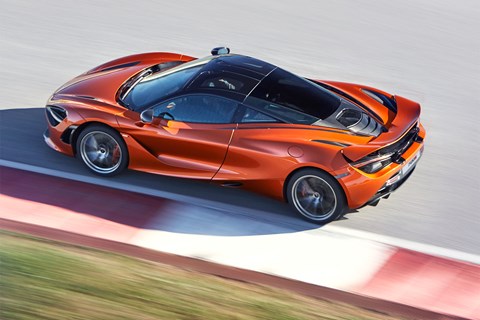
With a dry weight of 1,283kg (1,419kg with fluids and fuel), a mid-mounted 710bhp V8 (that’s 720PS, hence its name), a 212mph top speed, a barely comprehensible 0-124mph time of just 7.8seconds and an outstanding degree of advanced aerodynamic and driver assistance features, the 720S significantly ups the supercar ante with performance not far off that of the now defunct P1 hypercar.
Which means the confirmed three-seater BP23 hypercar, that will occupy the company’s top-tier Ultimate range is going to be certifiably unhinged.
Will the new McLaren be fun to drive?
‘Driver engagement was one of our key priorities,’ Haydn Baker, vehicle line director for the 720S, told us.
‘As its baseline, this car has to deliver the same level of engagement as the 675LT, but it must also posses the widest breadth of abilities of any McLaren to date. That’s why me focussed as much attention on visibility, packaging and access as we did on performance.’
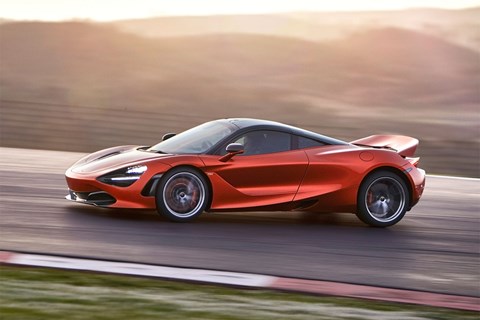
As if those mouth-drying stats weren’t enough, the 720S is also charged with spearheading McLaren’s hugely ambitious Track22 business plan, a £1billion research and development programme which will see the company significantly expand its product portfolio to include 15 new models by 2022 – the 720S will be the first – with at least seven of those featuring hybrid power.
Enough of the dry business stuff – talk me through the juicy bits
Let’s start with the styling. The 720S cleansheet design was dictated by the advanced aerodynamics needed to cool its innards and keep it velcroed to the road.
Key frontal elements include the predatory eye-socket LED headlight design that feeds air to car’s lower temperature radiators, and the diffuser that mimics that of the P1.

Those double-skinned dihedral doors channel air over the car’s flanks and in to the engine’s high-temp rads, negating the need for air intakes on the side of the car – a key visual differentiator against the 650S.
A full-width hydraulically actuated integrated rear wing – a la P1 – creates 30% greater downforce than the airbrake on the outgoing 650S. Together these aero features deliver a 15% boost to cooling efficiency and twice the overall aero efficiency of the 650S. Form, as ever, follows function at McLaren.
Does the same carbonfibre tub lurk beneath those swoopy panels?
No, in a word. The 18kg lighter and more robust Monocage II in the 720S is a significant new evolution of that deployed in the 650S, and features a fully integrated roof structure, with significantly slimmer pillars and larger areas for glazing for enhanced visibility.
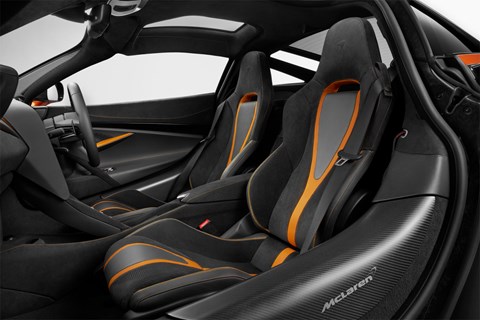
The all-new aluminium-intensive adaptive double-wishbone suspension, 390mm front and 380mm rear carbon ceramic brake discs and 19-inch lightweight alloy wheels are all mounted on the carbon tub using aluminium subframes.
The dihedral doors, opening at an 80-degree angle, now hinge forwards and upwards, and they incorporate a large section of the roof area. Combined with the markedly lower sills, they create a very large and accessible aperture for entry and exit.
And that engine – a lightly breathed on version of that in the 650S?
Hardly. The M840T 4.0-litre twin-turbo V8 bucks the current downsizing trend to further differentiate it from the 3.8-litre unit in the 650S.
It may only feature a modest 195cc increase in capacity (achieved by a 3.6mm increase in piston stroke) but a new cast aluminium inlet plenum, a set of lighter pistons, connecting rods and crankshaft, new fast-spooling twin-scroll turbochargers and intercoolers with electronically controlled wastegates and dump valve, and twin injectors per cylinder results in 710bhp at 7000rpm and a substantial 568lb ft of tyre-melting torque from 5,500-6,500rpm.
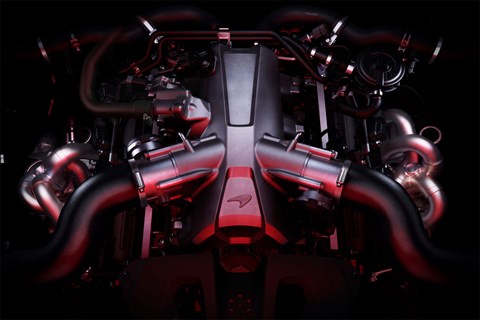
McLaren claims a ‘41% component-change’ compared with the existing 3.8-litre M838T V8 engine that still in services in the Sports Series range of 540C, 570S and 570GT models.
Despite these impressive gains of 69bhp and 68lb ft over the 650S, McLaren claims the 720S is 10% more efficient, returning NEDC combined economy and CO2 emission figures of 26.4mpg and 249g/km.
The compact new plenum chamber means the top of the engine is a full 120 mm lower than in the first generation of McLaren Super Series models, benefiting the centre of gravity as well as boosting rear visibility and luggage space (210 litres behind the rear seats and 150 litres in the nose).
The M840T drives the rear wheels through a heavily revised seven-speed SSG double-clutch transmission, with the choice of full automatic or manual modes. The rev-limiter is set at 8,100rpm in first and second gear and 8,200rpm in the remaining gears.
What’s the performance like?
The combination of a 1,419kg kerb weight, 710bhp and an armada of electronic drivers aids and features results in some truly brain-scrambling performance results:
- 0-60mph – 2.8 seconds
- 0-124mph (200kmh) – 7.8 seconds
- 0-186mph (300kmh) – 21.4 seconds
- 0-400 m / ¼ mile – 10.3 seconds
- Maximum Speed – 212mph (341kmh)
- 124-0mph (200-0kmh) – 4.6 seconds/117m
- 62-0mph (100-0kmh) – 2.8 seconds/29.7m
Any hybrid action in the mix?
No – and Baker explains why: ‘A hybrid didn’t fit into our model when we started developing the 720S four years ago. The 650S wasn’t a hybrid, and we wanted to maintain that model consistency.
‘And we also knew that incorporating hybrid tech would mean we wouldn’t be able to maintain a comparable price point with the 650S. That said, I still think we have launched a hypercar into the supercar sector.’
What’s the new cabin like?
As expected, the all-new cabin architecture is terrifically driver-centric, with significant emphasis placed on visibility, access and extensive glazing. Drop down into the driver’s seat and there’s no need to duck your head to avoid to roofline, and no wide sill to straddle – it’s as easy as getting in and out of an open-topped MX-5.
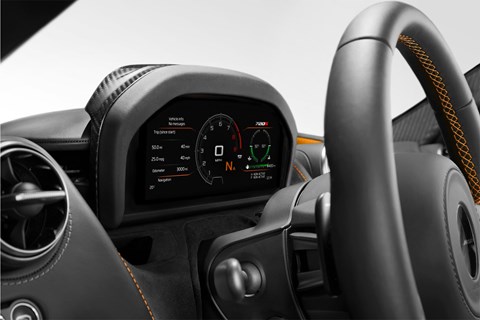
The central 8.0-inch screen gives the driver access to the infotainment and telemetry features, but the wow-factor highlight is the Folding Driver Display. In standard mode the compact high-def TFT panel displays the car’s three different layouts and colour variations according to the selected driver mode.
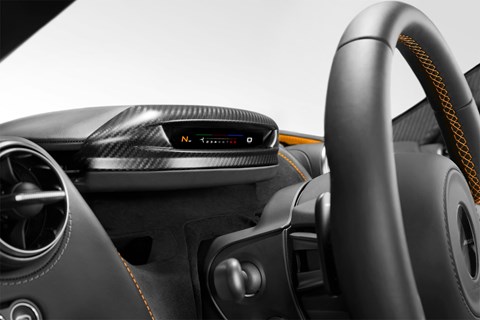
The Folding Driver Display can then switch to Slim Display Mode by pivoting and sliding down into the dashboard to reveal a thinner horizontal screen that contains the legal minimum of driver info, boosting forward visibility and reducing driver distraction. Perfect, then, for sighting that tricky apex when flat through Eau Rouge…
Any other sexy tech?
Oh, my word where to begin – this is McLaren after all.
McLaren’s Proactive Chassis Control II was jointly developed with the University of Cambridge using Optimal Control Theory. Drawing on feedback from 12 additional sensors – including one accelerometer at each corner of the vehicle to measure wheel acceleration and two pressure sensors per hydraulically-interlinked adaptive damper – data on cornering, acceleration, braking and aerodynamic forces is analysed and reacted to in two milliseconds. Like having Stephan Hawking in charge of chassis control…
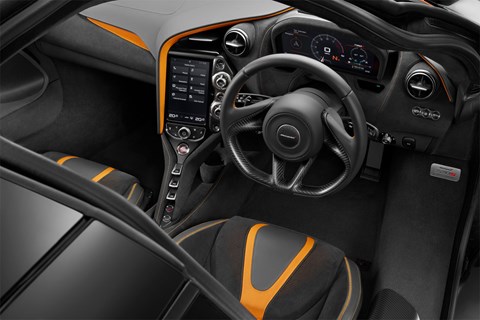
As before the Active Dynamics gives drivers the option of Comfort, Sport, or Track modes, according to personal preference and driving conditions, but this is complemented by the Variable Drift Control, which allows drivers to vary the intensity of the stability controls in Sport and Track modes, by using a slider control on the central infotainment display screen. In other words a drift mode for smoking up your tyres. Pirelli, which makes the bespoke 245/35 ZR19 front and 305/30 ZR20 rear tyres must be rubbing its hands in glee.
The electro-hydraulically assisted steering is now quicker than before and is governed a single software map in all chassis modes that dials in variable assistance levels for more nuanced feedback and response according to the choice of drive mode.
Unlocking the 720S engages a ‘Welcome Sequence’ – the wing mirrors unfold, the indicator courtesy lighting coming on, and the engine bay is illuminated casting a red light over the McLaren Speedmark logo on the cast-aluminium air intake plenum. See, McLaren does warm and fluffy, too.
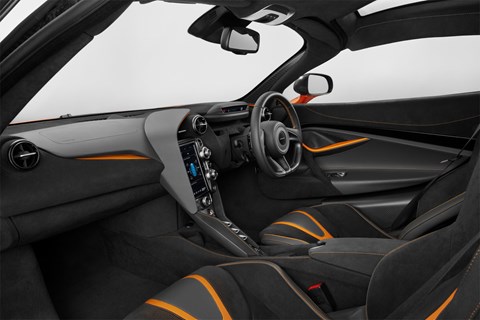
The optional Bowers & Wilkins audio system Kevlar mid-range speaker cones, and the choice of carbon fibre woofer cones. Because you can never have too much carbon fibre.
And let’s not forget the new Static Adaptive Headlights, which feature 17 LEDs per unit. Five provide the fixed base beam while the remaining 12 illuminate the road in the direction of the car’s nose. Long-range visibility is boosted by the automatic raising of the beam pattern by half a degree at speeds over 68mph for greater nocturnal illumination.
Click here to read more about the 2017 Geneva motor show on CAR
Read more McLaren news